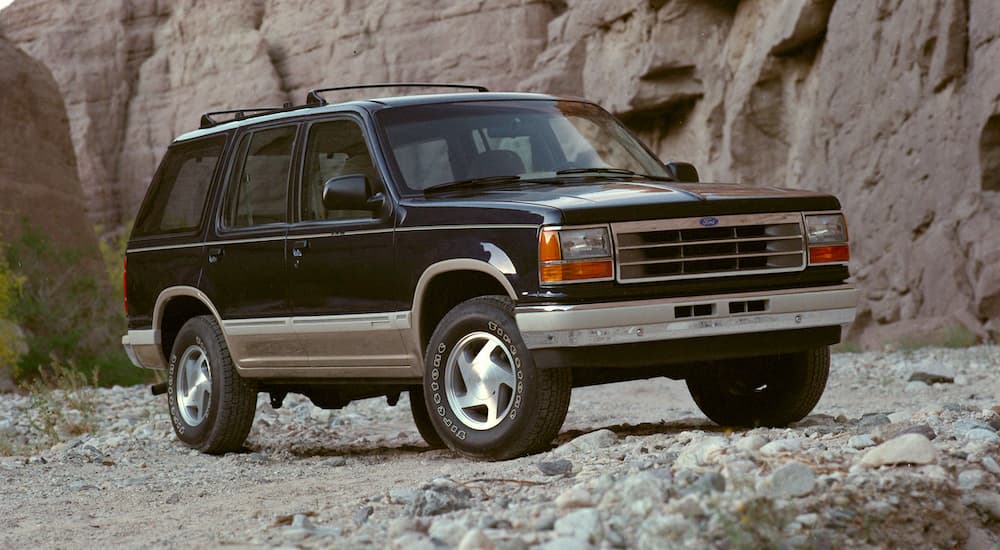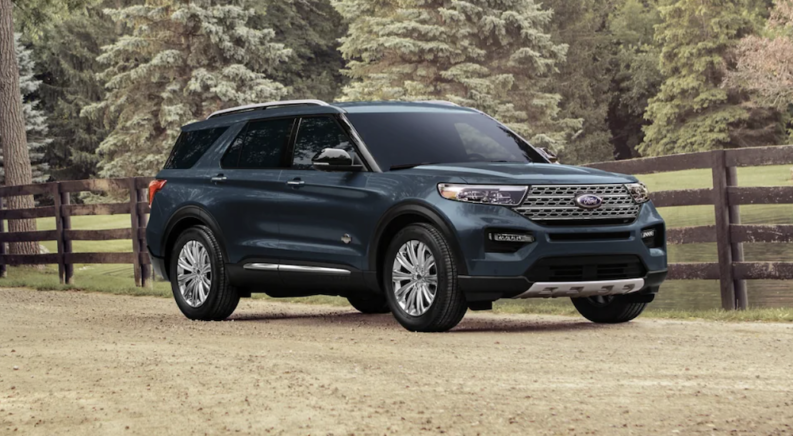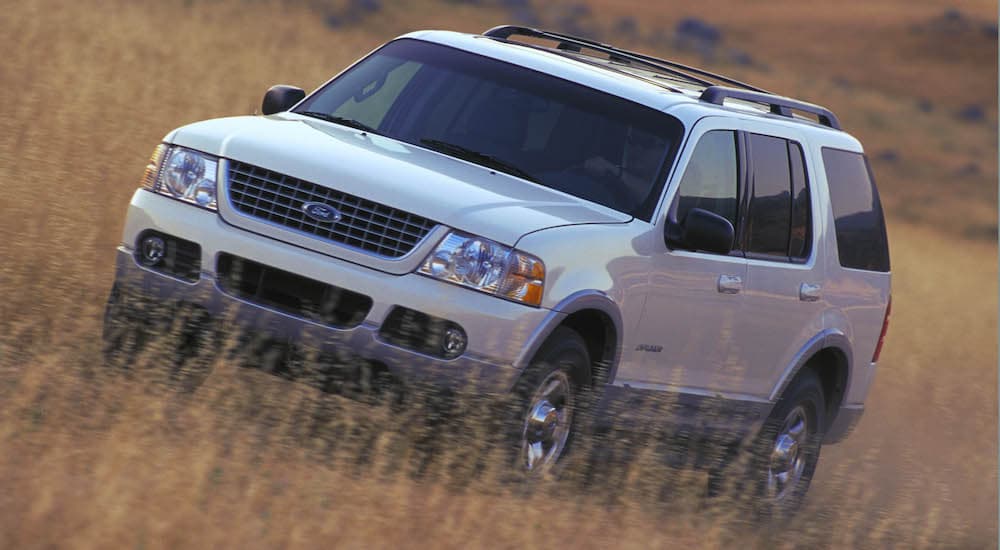If you visit just about any used Ford dealership, you’re sure to find several Explorers on the lot. Americans love our SUVs, and Ford’s Explorer is a popular option, coming in as the second best-selling midsize SUV of 2021, with some 220,000 vehicles sold that year alone. You don’t get those kinds of numbers overnight, so how did the Ford Explorer get to be the juggernaut it is today?
The Explorer has been around for over 30 years now, and it’s seen quite a few changes since it first rolled off the assembly line. Its history is an interesting one, and much of it reflects the shifting interests of American drivers over the past few decades. Let’s explore the timeline of this iconic SUV and see how it came to be the beloved model it is today.
Before the Explorer: The Bronco
Decades before the Explorer existed, Ford came out with the Bronco, a four-wheel drive vehicle that competed with the Jeep CJ. The Bronco became well known and respected as a durable model that could tackle off-road situations but still handle well on paved roads, with several of the features that draw people to SUVs today, like good ground clearance and a roomy interior. Over the years, the Bronco grew in size, leading Ford to consider a smaller variant.
For the 1984 model year, Ford finally introduced a more compact version of the Bronco, naming it the Bronco II. This midsize SUV was based on the Ford Ranger rather than the Ford F-Series and stayed in production through the 1990 model year, but it never quite took off the way the automaker wanted it to. It was so much smaller that it wasn’t able to offer the same practicality as the original Bronco. But this was the model that laid the way for the Explorer to enter the scene.

1991: The Ford Explorer Is Born
When the Bronco II was discontinued, the Explorer came along to take its place. The Explorer took many aspects of its design from the Bronco II and was also built on the Ranger platform, but it could easily be differentiated from its predecessor by a number of innovations. The Explorer was over a foot longer than the Bronco II, and where the Bronco II was only available with two doors, the Explorer could be had with four. The Explorer also sported a new body shape that made it more aerodynamic and compensated for its much larger V6 engine.
1995: The Second Generation
For the second generation, the Explorer’s extremely boxy look was rounded out, with smoother body contours and headlights and taillights with rounded corners rather than sharp angles. Other changes aren’t so obvious just from looking at it, like the fact that the Explorer included a new control-arm front suspension that’s more space efficient than the old Twin I-Beam system, giving Ford more room to play with under the hood. This made it possible for the company to offer a V8-powered Explorer for the first time in the 1996 model year, giving the SUV 210 hp.
1997: The Base Engine Gets an Upgrade
While the Explorer was now available with a V8, Ford wasn’t going to stop innovating its V6 options. For the 1997 model year, it added an overhead-cam V6 alongside the base pushrod engine. The new V6 was so capable that it managed to match the available V8 in horsepower, even though it didn’t provide quite as much torque. A five-speed automatic transmission also became an option this model year, joining the lineup alongside the standard five-speed manual and optional four-speed automatic.
2001: A Pickup Variant Emerges
In the 2001 model year, Ford released a pickup truck variant of the Explorer called the Explorer Sport Trac. The Sport Trac was designed to appeal to outdoor enthusiasts, with features that were unique at the time, like a composite cargo bed and a built-in power outlet (albeit a 12-volt socket rather than a standard 120-volt outlet like you might find in a modern F-150). It also included standard roof racks, rubber floor mats that could be hosed off after getting covered with mud during a long hiking trip, and a removable canvas bag attached to the front console.
While the Sport Trac attempted to be a cross between an SUV and a pickup, it wound up being difficult to distinguish from a regular pickup truck. At the end of the day, it just felt redundant when Ford already had the Ranger and F-150 in its lineup. The Sport Trac ran from the 2001 to 2005 model years and saw a brief revival for the 2007 to 2010 model years.
2002: Generation Three
While the Sport Trac went quietly into that good night, the Explorer proper continued to innovate and gain new fans. The third generation saw the SUV take a big break from its Bronco II origins, leaving the two-door bodystyle behind and adopting a new purpose-built platform with independent rear suspension. The 4.0L V6 carried on unchanged, but the 4.9L V8 was replaced with Ford’s new 4.6L overhead cam engine. Both four-wheel drive and all-wheel drive were available, giving drivers even more options.
2011: Exploring the Crossover Bodystyle
The 2011 Explorer left the body-on-frame bodystyle behind and changed from a purist’s definition of a sport-utility vehicle into a more car-like unibody crossover. This style has become a popular one among American drivers for a reason: it offers the large body and high seat position that SUV drivers love but with more car-like handling so that it doesn’t feel as much like a truck out on the road. Now front-wheel drive became standard, with all-wheel drive available as an upgrade. A new line of turbocharged Ecoboost engines replaced the old V6 and V8 options. The available 3.5L twin-turbo gave the Explorer Sport plenty of speed, launching the midsize SUV from zero to 60 in under six seconds.
2020: Hybrid Power Joins the Lineup
Electrification is all the rage for automakers today, and the Explorer joined in on the trend when it was redesigned for its fourth generation. More efficient than gas-only powertrains, the 2020 Explorer Hybrid earned an EPA rating of 28 MPG combined. That’s particularly impressive for an SUV the size of the Explorer. Don’t think that the hybrid is any less powerful than other powertrain options either: the combined output of the V6 engine and the electric motor gives the Explorer 318 hp to work with.
What’s Next for the Explorer?
Looking at the Explorer’s evolution so far, the clear trends are that it’s gotten sleeker, more powerful, more efficient, and more comfortable. Both its exterior styling and its various features have closely followed consumer trends, from little things like smoothing out boxy edges to major changes like switching up its body style to become a crossover.
As consumers are becoming more environmentally conscious, we wouldn’t be surprised if yet more electrification lies in the Explorer’s future. A traditional hybrid is a good start, but a plug-in hybrid or even an all-electric version seems possible down the road. Of course, the future is always unpredictable, and new trends are popping up all the time. One thing we feel fairly confident in predicting is that whatever trend takes hold of American drivers in the decades to come, the Explorer will be there to meet it.





